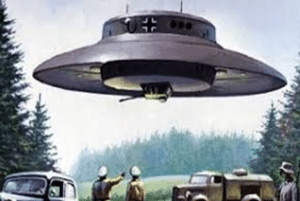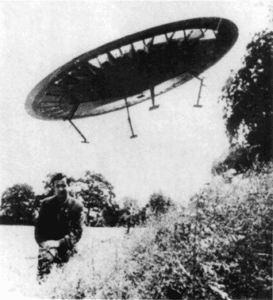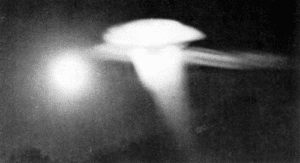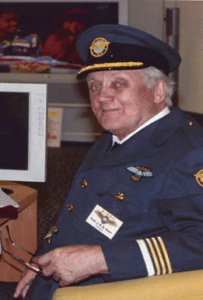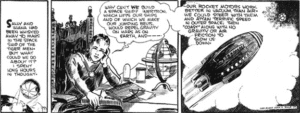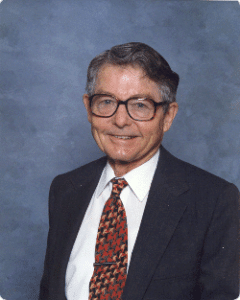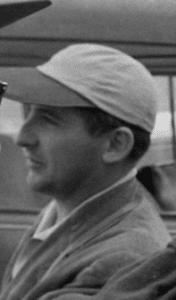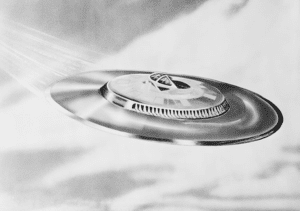By Dr. Raymond A. Keller, author of the international awards-winning Venus Rising series of books
Since the massive appearance of UFOs in our skies at the dawn of the atomic and space ages, the astounding power and maneuvering capabilities of these objects has long amazed engineers and scientists the world over. To greater and lesser degrees, these dedicated ones have tried their hands at duplicating the qualities manifest in the UFOs in both the design and construction of unconventional and experimental aerospace vehicles. In this series of articles, we look at some of the attempts by those on the cutting edge of anti-gravity and spacecraft propulsion research to build Earth-based versions of the legendary flying saucers.
The Nazis only got to test fly a prototype saucer one time, on 14 February 1945, outside Prague, Czechoslovakia, in the closing days of World War II. Thank God that sabotage by the internal German Resistance and Allied air raids thwarted the various Nazis’ secret weapons projects from coming to full fruition and deployment. Source of painting: Daily Mail, London, United Kingdom, 18 November 2010.
Flying Saucers and High-Tech Weaponry in Nazi Germany
The Nottingham, United Kingdom, Guardian Journal newspaper of 18 February 1957, reports that the Nazis had a prototype flying saucer in their armory of secret weapons in 1945. Allegedly, this circular aircraft could reach a speed of 1,250 miles per hour. The saucer, which was 138 feet in diameter, was designed by four engineers, these being three Germans and one Italian. Fortunately, because this aircraft was developed in the closing stages of World War II, an opportunity never presented itself for the Axis powers to deploy it against Allied forces. The saucer was taken for one test flight, however, on 14 February 1945, at Prague, Czechoslovakia. It supposedly reached a height of more than 40,000 feet and achieved the expected maximum speed of 1,250 miles per hour.
Reports of the saucer’s existence first appeared in the pages of Rudolph Lusar’s book, German Weapons and Secret Weapons of World War II and their Development (London, United Kingdom: Neville Spearman, English edition, 1959; original German, 1957). The book is considered credible by weapons experts worldwide, at least insofar as Lusar was the head of the Technical Arms Department of the German War Ministry from 1940-1945.
One of the many secret Nazi weapons covered in Lusar’s book include a vertical takeoff plane called the Viper. There were ten Vipers actually ready for action; but Lusar asserts that they were never used. Also, there was a radio-controlled flying bomb that was equipped with a television camera to allow it to be guided more accurately and remotely to its target by the bombardier aboard the aircraft it was deployed from. Lusar maintains that the United States military adapted the technology of this radio and television-directed bomb for the development of a similar device used against Chinese invading forces in Korea during the conflict that took place on that Asian peninsula (1950-1953).
Also, in the field of aviation, Lusar maintains that the Germans towards the end of World War II were working on the Heinkel 343, a bomber that could reach the Eastern United States and return to Europe without refueling and the so-called “V-9 Super Rocket.” This last mentioned weapon was an outgrowth of the V-1 and V-529 rockets which the Nazis fired at the British Isles. Had it been completed, the V-9 would have been capable of carrying a one-ton warhead to New York City in 35 minutes.
Other secret Nazi weapons included in Lusar’s book were various types of cannons: acoustic, electric and wind. The acoustic cannon was designed to kill enemy combatants with sound waves at a range of 70 yards. Lusar, however, writes that the acoustic cannon never lived up to the touted expectations of the Nazi war planners. The electric cannon, on the other hand, did make it so far as the experimental stage. According to the Technical Arms Department chief, this cannon was soundless, even while expelling a conventional shell by means of electricity. And then there was a wind cannon that could shatter boards at a distance of 200 yards with jets of compressed air, thus eliminating the need for expensive and manufactured ammunition.
On top of all this, there was also an automatic rifle that could fire around corners in house-to-house fighting. This type of advanced rifle was not duplicated until the early 2000s, when Lt. Col. Amos Golan of the Israeli Defense Forces came up with the “Corner Shot,” a weapon accessory now in common use by Special Weapons Attack Teams and special forces in hostile situations, usually involving the taking of hostages by terrorists.
Nazi Rocket Scientist Opines on Extraterrestrial Origin of the Flying Saucers
In 1940, at the onset of World War II, we find the rocketry pioneer, Hermann Oberth (1894-1989), working as a physics professor in the Technische Hochschule, a technical college, in Dresden, Germany. In the following year, Oberth moved to Peenemunde to work on Nazi Germany’s TOP SECRET Aggregate rocket program, where he achieved much success in the development of the V-series of rockets that were ultimately used to rain down massive destruction on lives and property in the British Isles. During the course of the war, he also helped the Nazis develop solid propellant anti-aircraft rockets at a facility in Wittenberg.
Despite his sordid past in the ranks of the Nazi scientific establishment, Oberth eventually came to the United States in the mid-1950s, at the behest of his former student Wernher von Braun, to work with him at a newly created space research facility in Huntsville, Alabama, run by the National Advisory Committee on Aeronautics, on the development of a fleet of space rockets for the United States. Oberth had published many technical papers on the possibilities of space-based reflecting telescopes, space stations, space suits and even electric-powered spaceships. Wernher von Braun convinced his American superiors at Huntsville that Oberth’s help with various on-going projects would prove invaluable. Of course, their research and rocket designs laid the groundwork for the establishment of the National Aeronautics and Space Administration (NASA) in 1958.
Hermann Oberth had some definite opinions about flying saucers, however, that are surely worth noting. In the American Weekly magazine (New York City) of 24 October 1954, the space scientist opined that, “It is my thesis that the flying saucers are real; and that they are spaceships from another solar system. I think that they possibly are manned by intelligent observers who are members of a race that may have been investigating our Earth for centuries.” And in an article that appeared in the May-June 1955 issue of the prestigious Flying Saucer Review (London, United Kingdom), Vol. 1, No. 2, pages 12-14, “They Come From Outer Space,” Oberth details the history of “strange, luminous objects” seen in the skies of our planet since the time of Pliny the Elder in the first century A.D. Roman Empire, and then writes, “Having weighed all the pros and cons, I find the explanation of flying discs from outer space the most likely one. I call this the ‘Uraniden’ hypothesis, because from our viewpoint, the hypothetical beings appear to come from the sky (Greek- ‘Uranos’).”
Other former Nazi scientists that have made their way to the United States under the auspices of Project Paperclip to contribute their expertise to research and development in various high-tech fields have made similar comments about the extraterrestrial origin of the flying saucers. Most notable among these was Oberth’s former student, Wernher von Braun, who made America’s Apollo Moon program the success that it was, stated to a reporter’s inquiries concerning UFOs on 3 June 1959, that, “We find ourselves faced by powers which are far stronger than we had assumed, and whose base is at present unknown to us. More I cannot say at present. We are now engaged in entering into closer contact with those powers, and in six, or nine-months-time, it may be possible to speak with some precision on the matter.” He also purportedly went on to aver that, “It is as impossible to confirm UFOs in the present as it will be to deny them in the future.” See UFO/UAP Alien News and Info Disclosure/UFO Scoop, https://ufoscoop.com/high-level-quotes-ufo-phenomenon/ (Accessed 2 September 2020), for direct quotes on UFOs from sundry authorities “in the know” on this subject.
From the comments made by the space research team of Hermann Oberth and Wernher von Braun, one can logically deduce that the Nazis may have gained some inkling of the advanced technology they were developing in the Third Reich from extraterrestrial sources. Oberth believed that the flying saucers originated from another solar system, although he wasn’t sure if they were manned or remotely controlled; and his student von Braun felt that the objects were manned and have been operating out of nearby secret bases for hundreds of years, perhaps under the Earth, on the backside of the Moon, or perhaps the closer planets of Mars and Venus, conducting an ongoing surveillance of our world and keenly watching our scientific and spiritual progress. Given the vast distances between the stars, it certainly makes sense that the extraterrestrials would conduct themselves in this manner.
Possible Methods of UFO Propulsion Examined, Part II
By Dr. Raymond A. Keller, author of the international awards-winning Venus Rising series of books
In 1968, British electronics wizard John R. R. Searl, now 88 years-old in 2020, designed, built and remotely flew over 20 different flying saucers, which he referred to as “levity disks.” Here in the photograph, Searl is seen with his prototype disk, with a diameter of slightly over 30 feet, hovering in the background. The design came from ideas he had first conceived back in 1949, while working as an electronic and electrical fitter for the Midlands Electricity Board in Worcester, United Kingdom.
Searl Effect Generator (SEG)
The heart of his design is the powerful Searl Effect Generator (SEG), which can allegedly run cold and perpetually. The details concerning the SEG are provided in this article. On 15 January 2008, Searl joined the faculty of the Institute of Infinity Sciences in the United Kingdom, where he was awarded an honorary doctoral degree in Space Science Research. The Infinity Sciences website maintains that Prof. Searl has supervised the construction of 30 more flying saucers since 1968.
Searl actually held no formal education, outside of his job at the Electricity Board, in the subject of physics. In some ways this was good, at least insofar as he remained unencumbered by conventional ideas of what was possible or not possible with electric motors and generators. While working with this type of equipment, however, the young Searl noticed that there was a small electromagnetic field effect that was produced by the spinning metal parts, i.e. the negative lines of force moving towards the outside and the positive towards the rotational axis. In 1950, the burgeoning scientist experimented with rotating slip rings, the inclusion which resulted in the measurement of a small electromagnetic field on a conventional meter. He also took note that when the rings were spinning freely and no current was taken, that his hair bristled. From these experiments and observations, he concluded that the free electrons in the metal must have been spun out by the centrifugal force, a centripetal force being produced by the static field in the metal. Therefore, Searl decided to build a generator based on this very same principle. His generator would be quite unique. It was to have a segmented disc rotor that passed through electromagnets at its periphery. These, in turn, would be energized from the rotor and serve to boost the electromagnetic force even more.
By 1952, Searl had built his generator along the lines he envisioned. It was only about three feet in diameter; but it was a start. He and a friend tested it out in the open. Its armature was set in motion by a small engine. The device produced the expected electrical power, but at an unexpectedly high potential. At the relatively low armature speeds, an actual potential on the order of 10⁵ volts was produced. This was indicted by the static effects on nearby objects, along with the characteristic crackling and smell of ozone. But then something unexpected occurred. The generator actually lifted while still speeding up, breaking the union between itself and the engine, while rising to a height of some 50 feet. It actually stayed aloft for the time it kept accelerating, and was surrounded by a pink halo.
What this indicated to Searl was that the air around the generator was ionized due to the reduced pressure at 10₋₃ Hg. Moreover, this created a side effect in that local radio receivers were involuntarily turned on throughout the Worcester area. The young scientist assumed that this was caused by the ionizing discharge or the electromagnetic induction. Finally, and thankfully, the entire generator sped up at a fantastic rate and is believe to have just “shot off into space.”
Since that day, Searl and others associated with his investigations and work have created some 50 flying vehicles, some of which had become similarly lost, at least until a control mechanism was developed and installed. As refinements were added, some of the craft were constructed of larger sizes, 12 and 30 feet in diameter, respectively.
Under the Radar
Searl began his research just two years after the age of the flying saucers began with the civilian pilot Kenneth Arnold’s sighting of nine disc-shaped objects flying in formation over Mt. Rainier in Washington State at an estimated speed of 1,200 miles per hour on the afternoon of 24 June 1947. The demonstrated capability of Searl’s generator and subsequent levity disks gave rise to a lot of speculation in the British Isles with regards to any connection between the local scientists’ creations and the appearance of flying saucers over the British Isles. And if the flying saucers were not created by Searl or any other human being, was it reasonable to assume that Searl had hit upon the motive force of these strange objects and that we, of Earth, could now produce flying saucers of our own, following Searl’s designs?
From 1949 through the present day, it is clear that government authorities in the United Kingdom and elsewhere have been keeping a close eye on those investigating the application of Searl’s generator to aircraft design. There have been some who have attempted to steal the details of his inventions, or to improve upon them. Those not willing to temporarily lay aside their preconceived notions of electromagnetic theory or the established “laws of science,” so-called, have prematurely concluded that Searl is either a crank or imposter. And as British science writer P. L. Barret opined back in 1968 in his self-published Barret Report, “There are some who are prejudiced by the attitude that new ideas are the prerogative of the hierarchy of intellectuals.”
Interest in the UFO Community
Barret was disappointed that Searl’s findings were being ignored in his home country of the United Kingdom. He felt that Searl and his associates were keeping their investigations and work “close to their vests,” so to speak, largely because the research bore such close connections in explaining the possible reality and power source of the enigmatic flying saucers. The public in the United Kingdom had largely been indoctrinated to scoff at the very subject of UFOs anytime it would come up for discussion. Overcoming this barrier of ridicule was just too formidable a task for most people back in the first 35 years of UFO investigations. Therefore, when Searl or others were asked about this phenomenon, they would always declare “no comment,” and leave it at that. Upsetting the uncertain structure of the existing scientific theory and the establishment that proffered it, would most likely bring nothing but derision and scorn upon the heads of any parties expressing an interest in UFOs or any other “esoteric” subject, such dowsing, ESP or alternative forms of healing, to name a few. Searl knew this, as well did any subject in the United Kingdom who happened to sight a UFO at any time during their life.
One has to wonder just how many of the bigger secrets of the universe have been unlocked by Searl or others investigating various methods of UFO propulsion. In this age of near continuing UFO revelations, the conventionalists better get ready to start reimagining a future where the Searl Effect is married to existing theory, lest they suffer the alternative fate of seeing the complete breakdown and subsequent revision of all physical theories from those of Ampere, Galvani, Volta, etc.
Possible Methods of UFO Propulsion Examined, Part III
By Dr. Raymond A. Keller, a.k.a. “Cosmic Ray,” author of the international awards-winning Venus Rising series of books
The Cosmic Ray explores the unusual electromagnetic effects associated with electrical wizard John R. R. Searl’s operational flying saucer, or “levity disk.”
John R. R. Searl’s advanced theories for the electromagnetic propulsion of aerospace vehicles certainly go far in explaining the effects of various UFO phenomena, some of which have been observed by Searl himself and others by the general public. Below the reader will find a list of sundry effects associated with the Searl craft as made manifest during the operation of his so-called “levity disks:”
- Antigravity, or levity.
- Very high electrostatic fields.
- Peculiar magnetic effect: The Searl generator produces a direct current static field with negative polarity at the rim and positive at the center. However, the magnetic field from the generator produces induction in conductive loops when there is no relative movement. This effect was evident in a UFO detector used by a club in the British Isles. This instrument, upon examination, was found to be a deflection magnetometer, i.e. a closed conductive loop. The presence of a craft is indicated by the deflection of the magnet from the north to south line. It seems, therefore, that the flux from the generator is continually expanding; and this implies an indefinite quantity of energy.
- Perpetual motion: Once the machine has passed a certain threshold of potential, the energy output exceeds the input. From then on, the energy output is virtually limitless. Searl explains this by stating that the machine collects solar energy. The estimated power output of the generator is some modest 10¹⁴ or 10¹⁶ watts, which puts the figure too high for a solar source.
- Inertia loss: Above the threshold potential, which must be some 10¹ᶾ volts, the generator and attached parts become inertia free. This, of course, jars with the accepted concept of inertia in mass.
- Drive: By altering the distribution of potential on the surface of the craft, it is possible to propel it. The preferred direction of travel at ultra-high speeds is away from the planet, with the plane of the generator being at 90 degrees to the gravity field. When in horizontal flight, the craft takes up an angle to the gravity field suggestive of a balance between like vector fields. The generator may produce a gravity-type field of its own.
- Ionization of the air: This is a simple electrostatic effect. It gives rise to a translucent glow surrounding the craft and glowing trails. The intensity of the field is such that it is capable of excluding the ionized air, creating a a near vacuum around the craft.
- Permanent electric polarity: Searl noticed that after working near generators or craft, he experienced a “cobweb” sensation on his skin. His clothes and bed linen clung to him. This was accompanied by occasional crackling and lasted some hours. This effect could be attributed to a permanent polarity of dielectric material. In this case, the material being body tissue. Little work has been done on permanent dielectrics; but reference may be found in the records of the Physico-Mathematical Society of Japan, 1920. This work was carried out by Professor Eguchi of the Naval College in Tokyo.
- Matter snatch during acceleration: This occurs when the craft is on the ground and the drive is suddenly switched on. The rising craft takes a lump of ground with it, thereby leaving the well-known hole in the ground.
Possible Methods of UFO Propulsion Examined, Part IV
By Dr. Raymond A. Keller, a.k.a. “Cosmic Ray,” author of the international awards-winning Venus Rising series of books
This UFO was photographed by James Lucci, 17, on 8 August 1965, at around 11:30 p.m., in the skies over Beaver County, Pennsylvania. James had gone out with his older brother, John, 23, to the outskirts of Beaver Falls to get away from the city lights to photograph a full moon, when they chanced upon this unusual object that appeared to be taking off. According to the Cosmic Ray, the glow surrounding the UFO is a clear demonstration of the Searl effect, where the atoms in atmospheric molecules are being ionized by the energized power coils of an interplanetary scout craft.
Application of John R. R. Searl’s Theory
In the 1 June 1968 issue of the Searl National Space Research Consortium Newsletter (Mortimer, Berkshire, United Kingdom), the application of John Roy Robert Searl’s ring generator is detailed by Consortium member, P. L. Barrett, B. Sc., an electrician who worked closely with Searl on his levity disks and probably understood their operational characteristics more than most.
According to Barrett, in its application, the ultra-high potential produced by the Searl ring generator is much greater than the ionization potential of the air. Acting as a positive electrode, this causes the ionic breakdown of the air at some feet from the craft’s skin. The negative side of the generator is connected to the periphery of the saucer and is isolated from the skin; while the field at the negative terminal is, therefore, very much greater with the air ionized at a greater distance from the rim. In this process, the air at the positive terminal loses electrons. The resulting ions are repelled away from the terminal with a high acceleration. The electrons, in turn, pass through the generator, constituting the current in the generator and providing the charge at the negative terminal to produce the negative ions in the air near the rim. The craft, therefore, is enveloped in a vacuum.
Comparisons Made
Barrett explained that in ordinary high voltage generators, the maximum potential is limited by the ionized breakdown of the air. Flashover occurs and the accumulated energy is lost. The geometry and arrangement of the field coils in the Searl generator, however, is such that the flashover is eliminated. And once the craft is enveloped in a vacuum, any occurrence of a flashover is rendered impossible.
Levity Process Explained
Here, in his own words, are the comments of Searl’s apprentice as he understood the application of his mentor’s theory:
“Energy is required to build up the potential and initially has to be supplied from an external source. As the vacuum layer increases about the craft, less energy is required to maintain the potential. The generator soon reaches a potential when the Searl effect takes place and the device produces its own energy along with the levity phenomenon. On the basis of the theory, at this potential the stress on the space fabric cannot be equalized by flowing magnetism (current flow) through the air and craft as a circuit. The space fabric breaks down to provide the magnetism to relieve the stress; but the energy by-product is absorbed by the generator which reinforces the field.
“The generator then must set up an ether flux along the lines of the electric field. The direction of ether flow is, however, in at the positive and out at the negative. This is deduced from the aether force theory of the German physicist Karl Schappeller. The generator and craft therefore reproduce its own gravitation- type field. The net effect of the craft field plus the Earth’s gravitation field gives rise to a condition where the ether density below the craft is higher than that above it.
“The craft, therefore, is strongly repelled away from the planet; and to stop it from shooting off into space, the field of the craft must be intentionally perturbed. In the drive condition, where the field is aptly reconfigured, the craft is shot out of the Earth’s field like a wet orange pip from between the fingers.
“The acceleration is enormous; but since all matter associated with the craft is linked with the field, no distortion of any part, including passengers, if any, occurs. The limit to the speed is unknown; but since the craft has no inertia, there is possibly no limit. It would be safe to say, however, that the limit is below the speed of light. Above this speed, too much is unknown to take the risk; but since the craft carries its own space with it, the theory of relativity is inapplicable. In fact, the craft does not travel through space, but past it.”
German aether physicist Karl Schappeller (1875-1947) and diagram for his Schappeller device, an advanced generator that included:
- Steel outer casing.
- Special ceramic lining in which tubes are imbedded.
- Hollow center filled by glowing magnetism when in operation.
- Tubes, circuit and grounding.
In attempting to understand the basis of aether physics, keep in mind that the universe can be considered as an infinite “sea of energy,” forming a background of energy everywhere simultaneously. Aether is, therefore, an energy source emanating from everywhere at once. Therefore, it would be extremely difficult to make any independent measurements of this energy source. Also, the aether is always in motion; and like any form of energy, it is radiant. In accordance with aether theory, the aether would encompass both electromagnetic radiation and gravity radiation. While Newton described the effects of gravity, he never told us what it was. In aether theory, gravity is really a push, not a pull. Gravity is acceleration and is caused by the aether field. And since all energy is radiant, its fundamental basis is aether radiation.
With aether radiation as the underlying cause of gravity, then one can logically assume that it, like any other radiation, can be converted to mass or under certain circumstances, reradiated or converted to other forms of energy. Hence, no unified field theory is necessary as the aether field is the unified field. And there would be no need to look for a separate anti-gravity, at least insofar as gravity is a push, then it is all anti-gravity. All one needs do to construct a flying saucer, then, is to find this particular frequency of gravity and find a way to generate it.
It is clear from the work of Schappeller and Searl that these two scientists had come to grasp this important fact about the aether force. Most in the scientific community have been led to focus on Albert Einstein and his theories of relativity, and several generations of physicists have literally spent their lifetimes on trying to prove Einstein correct. However, this misguided thinking has apparently led to these scientists in painting themselves into the proverbial corner, so to speak. One merely has to look at the many “free energy” devices which have arisen over the past century, in spite of accepted scientific theory, to see that this statement is true. Going back to the time of Schappeller in Nazi Germany, we see that the German scientists labored under no such illusions about Einstein’s theories. In fact, they never abandoned aether physics for the physics of relativism, as it has been traditionally taught in schools. The aether physics, the more esoteric type, was utilized secretly by the Nazis in developing the prototype flying saucer described in Part I of this series, and subsequently in the fabrication of TOP SECRET space vehicles and weaponry, by the extant military powers of the Earth.
For further information, see https://www.aetherforce.energy/the-karl-schappeller-device/.
Barrett provided a detailed gravity field diagram in the aforementioned 1 June 1968 newsletter, wherein neutral zones appear below the craft and the ring above, during those times when the levity drive was activated. If matter became located in that zone, then it would be held there. Consequently, the Searl craft as constructed up through the time that Barrett published his report, had left their mark in the countryside in the form of large, neat holes after the saucers had taken off, i.e. every time a saucer was launched, a chunk of earth was taken up with it.
The gravity field within the body of the craft is such that the center is up and the rim is down. Therefore, if the generator is allowed to run up in those instances
where the polarity is opposite to that of the Schappeller device, the field is expansive and pulls the craft apart. Prior to this, glowing magnetism could tart, characterized by an orange yellow glow, but could not become self-sustaining, being in an expansive state. The Searl generator runs at low speeds is, therefore, unlikely to fly apart by centrifugal force. Part from this side effect, electromagnetic forces help to keep it together. As with other gravity fields, the flux favors passage through matter. As such, the field within the craft may be tailored by appropriately distributing the mass within the craft. This will prove particularly convenient in manned craft where crew comfort can be significantly improved where the cabin field is about ½ g.
When travelling in free space, Barrett reports that the external field would resemble that of the combined Earth and the craft insofar as it would be moving relative to a stationary field.
According to Barrett, “Collision between the craft and large objects in space is very unlikely except in a direct line of flight when such could be seen and the craft rapidly turned. The field is such that the objects are diverted past the craft, or it (the field) past the object. If the object qualifies as a planet or moon having its own gravity due to a glowing core, then the craft oriented by the interaction of fields is strongly repelled away unless measures are taken to alter the field of the craft. Small objects such as meteorites are pushed out by the combined electric and dyno-magnetic fields. An object entering such a powerful statis field is at first attracted, then ionized and then strongly repelled. The dyno-magnetic field induces an ordinary magnetic field in objects which will interact with the craft’s ordinary magnetic field at considerable distances (miles), and repel it.”
It is important to keep in mind that only a very small amount of space fabric actually passes through the craft; and even a smaller amount is converted for energy. However, as Barrett pointed out earlier, small changes in the ether will lead to large, physical changes.
“Even in deep space,” Garrett postulated, “the craft has an electromagnetic flow through the generator which is continuous along the electric field outside the craft. Electrons are picked up and some leave the rim at relativistic velocities. These do not contribute to the drive. Ergo, the craft carries its own negative space charge. In an atmosphere, the electronic flow is much greater and the generator current much higher. The craft, therefore, functions a lot better and has greater flexibility in space. In air, the recombination of ions in the air can give rise to condensation. This effect, coupled with the output of electrical energy, could well precipitate thunder storms.”
Minor Deficiencies
Barrett insists that the only hazard that he had observed was that when the craft hovered for too long close to the ground, the soil became burnt. This was due to the electric currents in the craft, which built up heat. Also, the apprentice to Searl noticed that the nervous systems of animals were interfered with by the ionizing discharge of the object, if they got too near it. Birds in flight had been really hurt by these discharges as well, losing their sense of internal guidance and flying uncontrollably into stationary objects.
John Roy Robert Searl, photographed in 2014.
Unanswered Questions
Of course, J. R. R. Searl and his levity disk generator have served to “generate,” pardon the pun, an amazing amount of controversy over the years, especially in the UFO community. If some extraterrestrial civilization has found a way to get around the all-pervasive force of gravity, that would certainly go a long way in explaining the presence of so many UFOs in our skies. And in emulating these UFOs, i.e. in trying to build such interplanetary vehicles, the ability to unhook ourselves from Earth’s firm grasp would be the first, if not the most important step, in this process. But is Searl’s version of such a flying saucer the way to go?
As Dana Custer of the Electric Spacecraft Journal, previously referenced, has pointed out, there are some difficulties here: “For a variety of reasons, Searl seems unable or unwilling to give out clarifying information. He has said that he has flown a number of these discs, and that some rose up, hovered, and then disappeared, going straight up into space. But where are the eye-witness accounts? The Barrett report stated that there were indeed eye-witnesses, but they remain unidentified.
“Searl is considered pretentious by most of the scientific community; and his work, therefore, is thought to be suspect. He is a self-taught scholar; and his explanations may elude the more formally trained. The concepts involved are intriguing- electricity, magnetism, the glowing corona. The explanations are complicated; but they sound convincing.”
Naturally, we would all like to see the realization of the antigravity devices and resulting benefits that Searl’s explanations suggest. Custer admits that we all want this so much that we are, “willing to investigate even the most obscure references.” But it would be tremendous, at this point, to be able to interview some verifiable eye-witnesses. Or even better, how about being an eye-witness to the proper application of a Searl Generator, actually noting the reproduced effects?
Possible Methods of UFO Propulsion Examined, Part V
By Dr. Raymond A. Keller, a.k.a. “Cosmic Ray,” author of the international awards-winning Venus Rising series of books
Financial guru Roger W. Babson declared a one-man war on gravity following the drowning of his older sister, who was pulled down to the bottom of a river on the outskirts of Gloucester, Massachusetts, during his youth.
“Wizard of Wall Street”
Roger W. Babson (1875-1967) was a self-made man who amassed a great fortune on Wall Street by applying the laws of gravity toward making accurate stock market predictions. He was such an outstanding technical investor that many in the circles of high finance came to call him the “Wizard of Wall Street.” At the start of 1949, he dedicated a goodly portion of his vast financial resources to establish the Gravity Research Foundation (GRF) in New Boston, New Hampshire. The first meeting of the GRF was held on 19 January 1949; and on 1 December of the same year, the first awards for the best essays submitted on the subject of gravity were made.
Babson graduated from the Massachusetts Institute of Technology (MIT) in 1898 with a bachelor of science degree in engineering. It was Babson’s interest in gravity that propelled him to enroll at MIT. This fascination with gravity actually began back in Babson’s childhood, following the drowning of his older sister in a river on the outskirts of Gloucester, Massachusetts. Babson referred to gravity as “our enemy number one” and then elaborated on the origin of his obsession in overcoming this force of nature: “She (his sister) was unable to fight gravity, which came up and seized her like a dragon and brought her to the bottom.”
At MIT, Babson’s favorite class was that taught by the engineering professor George F. Swain. Dr. Swain, to highlight his lectures and keep his students’ attention, used stock market charts to illustrate the application of Isaac Newton’s laws, most notably the law of action and reaction. Babson used the exercises learned in the class to develop his own method of analyzing the stock market and making profitable investments. From Dr. Swain, Babson learned how to draw a nominal line through zigzagging market action on financial charts. After moving on from MIT, Babson established his own investments firm and taught this technical skill to one of his brokers, Alan H. Andrews, who later refined it into “Andrew’s Pitchfork,” a now commonly utilized trendline indicator.
According to the Forex Trading Group, “The Andrews Pitchfork is an on-chart technical indicator that is drawn around recent price action. It falls into the category of channel indicator studies. The structure of the Andrews Pitchfork indicator consists of two parallel lines and a median line in the middle.
In this manner, the Andrews Pitchfork drawing tool has three parallel levels which are equidistant. It is used to gauge the price behavior during an emerging or prevailing trend.” For further information, see https://forextraininggroup.com/rules-for-using-andrews-pitchfork-and-median-lines/.
Interestingly, and unlike countless other investors, Babson and those following this technique, were able to avoid the calamity of the stock market crash of 1929 by selling off early, reaping exceptionally high profits. Just a couple of weeks before the stock market plummeted to record lows, Babson remarked that, “Inasmuch as there was strong upward action, there would now have to follow a severe downward reaction,” adding that, “What comes up will come down, and the stock market will fall by its own weight.”
In the years following World War II, the theory of gravity was largely a neglected area of research in the scientific community and Babson wanted to energize it. To this end, he consulted his close associate, George M. Rideout, then President of Babson Reports, his primary stock analysis firm, as to how best to proceed to encourage the study of gravity. After some consideration, George Rideout advised him to start a foundation and to solicit ideas by offering annual awards for the best ideas submitted. Roger Babson accepted the advice and the GRF was formed. The GRF is still in existence, but still little known to most in the UFO community, to whom it should matter most.
According to the GRF website, “Babson’s main interest was to stimulate interest in the study of gravity. He hoped that ultimately unique and practical applications would be found. His views were reflected by the wording in the announcement of the first essay competition that said the awards were to be given for suggestions for anti-gravity devices, for partial insulators, reflectors, or absorbers of gravity, or for some substance that can be rearranged by gravity to throw off heat. Although not specifically mentioned in the announcement, he was thinking of absorbing or reflecting gravity waves. The wording was unusual and the scientific community responded with a resounding lack of enthusiasm. George Rideout recognized that the wording discouraged the best scientists from submitting essays. He succeeded in convincing Babson that, if one understood completely the theory of gravity, one would understand its possible applications. He was able to modify the statement in the annual announcement of the essay competition so that it has been for many years, and almost from the beginning, stated that the awards are given for essays on the subject of gravitation, its theory, application, or effects.”
Although Babson’s obsession with gravity was considered, by most, nothing more than a “pipe dream” back in 1949, in today’s world the theory of gravity is one of the more active areas of research in theoretical physics. And most ufologists subscribing to the extraterrestrial hypothesis for the origin of UFOs would heartily agree that a thorough and comprehensive theory of gravity is needed to explain the existence of flying saucers as interplanetary spacecraft covering the immense distance between the stars in such presumably short time spans.
The GRF website acknowledges that Babson, if he were still alive, would certainly recognize that he erred in not thinking boldly enough. The site continues:
“Instead of terrestrial applications, he should have thought of cosmological; instead of static fields, he should have thought of dynamic and radiative effects. Anti-gravity he would now know was associated with dark energy, rearranging matter to produce heat he would associate with Hawking radiation from black holes. He would be doubly excited to know that gravitational radiation has been observed and that a new window for cosmological events has been opened. By any measure, he would feel vindicated in his judgment and satisfied that indeed the study of gravity was no longer being neglected, and it is likely that when gravitational radiation is observed, absorption by other galaxies will also be observed.”
In his later years, Roger W. Babson (left) continued to ponder a utopian future where the application of anti-gravity technology would become a reality. Photo from Babson College archives, Babson Park, Massachusetts.
In looking at gravity as a radiation, we now find ourselves right in line with the speculations offered by John R. R. Searl. In the next section, we shall look at the GRF essay winners for 1949 – 1953, and see how their research was coopted for the development of TOP SECRET aircraft in the United States during the mid-1950s, i.e. the beginnings of the so-called “Skunkworks” and the emergence of an anti-gravity aerospace technology that remains largely hidden, even unto this modern age.
Possible Methods of UFO Propulsion Examined, Part VI
By Dr. Raymond A. Keller, a.k.a. “Cosmic Ray,” author of the international awards-winning Venus Rising series of books
David B. Wittry, Ph.D., Materials Science and Electrical Engineering
(1929-2007), early pioneer in anti-gravity research; for a thorough biography see http://www.davidwittry.com/.
Gravitational Screening
Back in 1949, when David B. Wittry was studying for a bachelor of science degree in applied math and mechanics at the University of Wisconsin at Madison, the burgeoning young scientist was already thinking outside the box, especially when it came to challenging and reconceptualizing our then widely held, but erroneous concepts, about the unfeasibility of building anti-gravitation devices. In his award-winning essay submitted to Roger W. Babson’s Gravity Research Foundation (GRF) of New Boston, New Hampshire, in that year, on the “Possibility of Discovering an Absorber, Insulator or Reflector for Gravity Waves,” Wittry took note that, “Serious scientists are not supposed to concern themselves with freedom from gravity. Such ideas make exciting material for pulp magazines; but anyone who seriously considers screens for gravity is immediately set off as a potential crackpot.”
Wittry did not believe that this was fair. Scientific exploration should not be restrained as there are no limits in the acquisition of knowledge. “The method of science has always been one of careful observation, generalization and mathematical expression, and then deduction and prediction,” the young scientist asserted. He added that, “A theory to be valid must be found true in subsequent experimentation and observation. But the theory must be careful not to indicate anything which is known to be absent.”
Young Wittry felt that the then extant tendency in developing theories on gravity that ignored the one effect that could not be adequately explained, gravitational screening, was quite unfortunate. Of this phenomenon, he pointed out that, “Gravitational screening is the one effect crucial in all theories of gravitation. The absence of any gravitational screening would make gravitation almost unique among physical phenomena; while the existence of it would be contrary to the myriad daily observations made consciously or unconsciously by everyone.”
Wittry saw Newton’s law as a convenient starting point in looking at the subject of gravity, especially since it has stood up over the centuries in which other physical concepts were constantly changing. The university student was concerned about the overall implications of Newton’s law, especially if they can still hold up under the light of new observations. The way that Wittry saw it, Newton’s Law of Gravitation implied that gravity was independent of the following:
- The physical condition of the mass, i.e. solid, liquid or gaseous, amorphous or crystalline.
- The chemical composition of the masses.
- The temperature of the masses or of the intervening medium.
- The directional effects.
- The nature of the intervening medium and that it acts as if were concentrated at the centroid of the masses for large distances.
Any new theory on the mechanism of gravity must take into account even the slight existence of gravitational permeability. According to Wittry, “All the theories advanced in the two centuries from Newton to Einstein have failed because they indicated gravitational permeability, and because no such effect is definitely known to exist.”
Promising areas of research were foreseen by Wittry back in 1949, however, and these included particle theories and other theories that might help to explain gravity in terms of electromagnetic fields. As Wittry saw it, particle theories made gravitation a push due to greater pressure on the far sides of two bodies than between them. Unless the matter possessed some way to stop the particles in the form of waves or rays, there could be no gravitation between them. And as to electromagnetic field theories, the presence of a screen effect is also implied insofar as it is impossible to imagine any combination of electric and magnetic fields in which one or both elements are not subject varying permeability in matter. Interestingly, these lines of research corresponded nicely with the investigations then being conducted in the British Isles by John R. R. Searl, which we covered in previous articles.
It is clear that the work being done at the GRF from the period of 1949-1953 was both keeping the subject of anti-gravity in the public’s attention as well as laying the groundwork which was pushing the subject into the realms of respectability in the scientific community. By 1954, we will start to see more involvement in this subject on the part of the United States government, with lucrative contracts being awarded to universities and corporations for the development of actual anti-gravity technology and the construction of aerospace platforms that mimicked the speeds and maneuverability of the UFOs then being sighted in ever-increasing numbers the world over.
Buck dreams of an anti-gravity rocket from the Buck Rogers 2429 A.D. comic strip by Philip Nolan and Richard Calkins. The “Tiger Men of Mars” arc appeared in the Evening Gazette of Worcester, Massachusetts in the winter of 1929.
Possible Methods of UFO Propulsion Examined, Part VII
By Dr. Raymond A. Keller, a.k.a. “Cosmic Ray,” author of the international awards-winning Venus Rising series of books
Richard Alan Ferrell, Ph.D., Physics (1926-2005), early pioneer in anti-gravity research; for a thorough biography see https://umdphysics.umd.edu/about-us/2-uncategorised/539-richard-a-ferrell-.html.
The work of the Gravity Research Foundation (GRF) of New Boston, Massachusetts, was proving invaluable in attempts at extending theories of anti-gravity into the general discourse of the scientific community, moving the subject from the realm of “crackpots” into abstraction and generalizations based on a wide array of observations and the results of sundry experimentation. In the GRF award-winning essay selected for 1950, a then graduate student in the physics department at Princeton University in New Jersey, Richard A. Ferrell, turned his attention to the two principal features of general relativity as a field theory and how it relates to the gravitational interaction of matter. These included:
- The production of the field of disturbance in space by the matter existing elsewhere. One portion of space is considered to influence (more strongly if it contains matter) its neighbor, the latte to pass on the condition in turn to its neighbor, and so on until the disturbance has been extended throughout the universe. This situation is analogous to the spreading of waves over the surface of a pond. There are partial differential equations to describe accurately how the neighbors act on one another.
- The exertion of actual forces upon matter at any given point by the field or disturbance which happens to exist at that point.
From his preliminary analysis of this two-part theory, Ferrell initially thought that he might be able to attack the problem of finding gravitational shields, absorbers, reflectors or similar devices through an investigation of either of the two aspects separately. He was hoping to find a new way of producing the field or a new way of having the field act upon the matter. However, Ferrell noted in his GRF 1950 essay on the “Possibility of New Gravitational Effects,” that, “A particle which, according to the second aspect of the theory, is acted upon by the field will also produce a field of its own. When this is added to the original field already present, one is able to describe the total field in terms of the equations of the first aspect of this theory. These equations require the field at every point of space to change in a certain manner with time, and thereby also specify the way the portion due to the particle alone varies with time.”
The young scientist continued to clarify this complex subject: “But because the particle and the field it produces are intimately connected, we consequently see that the motion of the particle is also determined by the first aspect and that the second aspect is not actually a separate, independent phase of the theory. The realization and proof of this fact is a development of recent years. More precisely, Einstein, Schild and Infield have proved that the equation of motion of a particle can be derived from gravitational field equations.”
Essentially, following Einstein’s long road of equations had led Ferrell down to a dead-end street when it came to finding any possible access it might afford to new and useful effects such as the shield, reflection or absorption of the gravitational field. The scientist surmised that, “This does not mean that new effects are not likely to be discovered. However, these future effects will surely be rather subtle to have gone unnoticed for so long. Such, for example, was the case with the discovery of the laws of electromagnetism by Faraday and Maxwell. Only much later did these slight and previously unnoticed phenomena become the basis of dynamos, electric motors, radio, etc.”
Farrell did admit that the scientific community of the early 1950s should remain optimistic about finding a unified field theory which will adequately describe both gravitation and electrodynamics. He noted that Einstein’s latest theory had not yet reached that important stage; but, in the young scientist’s estimation, Einstein’s theorizing gave every indication of at least moving in the right direction toward achieving this end. Clearly, when such a comprehensive theory appears on the scene, it should give many predictions of completely unsuspected phenomena, depending upon the interaction of electric charges and the gravitational field. The great difficulty with laboratory experiments involving general relativity, however, would be in measuring the extremely small effects.
The Princeton graduate student addressed this issue: “However,” he declared, “if coupled with the much stronger electrical effects, general relativity might be made an experimental field of investigation and brought into the laboratory for the first time. Work in both the theoretical and hopefully, later the experimental aspects of this subject should be strongly encouraged as it could be very fruitful.”
What history has shown is that a frontal attack in science does not necessarily prove to be the most successful approach. Endeavors that are guided primarily by the desire to know and to understand the laws of nature have proven to be the ones that have resulted in becoming the most beneficial to the progress of humankind, i.e. backyard mechanics like John Roy Robert Searl in the United Kingdom trying to build their own versions of flying saucers or Nikola Tesla designing electric airships based on dreams and visions.
Of the two aspects of Einstein’s theory, however, Ferrell did admit that, “There is only one feature to consider in surveying known and in scouting for unknown gravitational effects, viz. the production of the field by matter.” Isn’t it interesting to note that Searl postulated that gravity was a particle? Since it emitted radiation, he assumed it has a mass.
Replica of I-beam composed of unknown alloy and inscribed in type of hieroglyphics recovered from the Roswell, New Mexico, UFO crash site on 7 July 1947 by Army Air Corps crash retrieval detachment personnel. Entire craft was supposedly fabricated with the same alloy.
Possible Methods of UFO Propulsion Examined, Part VIII
By Dr. Raymond A. Keller, a.k.a. “Cosmic Ray,” author of the international awards-winning Venus Rising series of books
Trevor James Constable (1925-2016) at the 1957 Interplanetary Spacecraft Convention at Giant Rock Airport in Landers, California. Trevor was the first to propose the idea that UFOs were themselves ethereal beings from a quantum dimension projecting only the image of physical spaceships.
The 1951 annual award of the Gravity Research Foundation (GRF) of New Boston, New Hampshire, went to Myron Jordan Lover, Ph.D., Thermodynamics, of Ozone Park, New York, for his essay on the “Thermodynamic Aspects of Gravithermels.” According to Lover, “In spite of their many shortcomings, the concepts of thermodynamics still enjoy referee status for problems concerning heat and other forms of energy. It is sometimes fortunate,” he noted, “that the laws of thermodynamics are based on experience rather than pure reason. Thus, when we pose the question, ‘Is it possible to discover any alloy the temperature of which can be affected by gravity waves?’ thermodynamics replies with a resounding affirmative, but only after we have subjected specific systems to its scrutiny.
“It is comforting to realize that such alloys are neither startling nor unprecedented. Thermodynamics anticipates their discovery, sanctions their use by reference to systems currently accepted in our philosophy, and even tells us the properties we ought to seek in order to discover the most efficient alloys.”
Lover created the term “gravithermels” to designate those alloys which may be heated or cooled by gravity waves. The scientist maintained that his coining of this word followed the modern practice that has produced such words as “thermistor” and electrad.” And in his broadened definition of gravithermel alloys, Lover included non-metallic systems that allowed for the removal of needless restrictions put on the practical application of his ideas, with conclusions independent of the chemical nature of the materials involved.
With respect to the UFO phenomenon, this opens up some interesting possibilities. Trevor James Constable (1925-2016), a native of New Zealand and communications officer for ships of the Matson Line, was also known as one of the contactees of the 1950s and frequent speaker at George Van Tassel’s Interplanetary Spacecraft Conventions out at Giant Rock Airport in Landers, California. As a pioneer ufologist, he advanced the “space critter” theory in his book, They Live in the Sky (Los Angeles, California: New Age Publishing, 1958). The author describes his own telepathic contact with an invisible being, and how, at the suggestion of this ethereal intelligence, he began experimenting with infrared film in conjunction with the elementary principles of spiritual science.
From this entity, Constable learns that flying saucers operate mainly in a quantum universe, unseen by humans but on rare occasions. Some of the UFOs that we do observe, however, consist of both physical craft and living, biological creatures. The book shatters many misconceptions generally held by ufologists and offers, instead, the twin premises that these UFOs are ultra-dimensional and living organisms that take on the appearance of spacecraft when they materialize in our atmosphere, possibly playing off the observer’s shared conceptions of flying saucers and their occupants in the collective consciousness. These entities, emanations from a quantum universe, would certainly have ethereal bodies that defied the known laws of our reality. In one sense, these entities can be viewed as consubstantial with the perceived UFOs, thereby exhibiting the ability to morph into anything they wish to project to us. This is where a tie-in comes with the work in thermodynamics conducted by Dr. Myron Jordan Lover.
Ultraviolet camcorder footage of bioenergentic phenomenon similar to that described by Trevor James Constable taken by paranormal researcher Nik Hayes from the roof of his home on the outskirts of Oxford in the Untied Kingdom on 18 July 2016. See Journal of Psychiatric Orgone Therapy, 15 July 2019, https://www.psychorgone.com/tag/trevor-james-constable.
On the other hand, Constable does not discount the possibility that some of the UFOs may, indeed, be extraterrestrial spaceships of a physical nature. Examples of the physical material from these types of UFOs may have been recovered by Air Force’s Space Reconnaissance Office, headquartered in Dayton, Ohio. The universe is a big place, after all. There is a plenty of room for a endless multitudes of intelligences at all planes of existence, all densities, all dimensions, all modalities.
In returning to Dr. Lover’s essay, however, we see that he provides the equations which demonstrate that substances varying in temperature under the influence of gravity waves were already known. The question, therefore, is reduced to one of degree rather than kind. Thermodynamics pointed out the way to the production of alloys which may be on the orders of magnitude more efficient than previously known, or even suspected.
Possible Methods of UFO Propulsion Examined, Part IX
By Dr. Raymond A. Keller, a.k.a. “Cosmic Ray,” author of the international awards-winning Venus Rising series of books
Since the dawn of the Age of Flying Saucers in the summer of 1947, the idea of creating functional anti-gravity space vehicles of our own has been foremost in the mind of defense planners. Above, artist’s conception of the vertical rising disc-shaped aircraft under development in the mid to late 1950s for the United States Air Force through a contract with Avro Aviation, Ltd., of Canada.
From Anti-Gravity Theory to Application
Gabor Strasser of New York City was the first-place winner of the 1952 Gravity Research Foundation (GRF) national award for his essay on “Gravity and the Dimensional Constant ‘G’.” In this paper, Strasser looked at various experiments performed in the field of physics taking into account Newton’s Second Law, the Universal Gravitation Equation, Electric Fields and Magnetic Fields. All experiments carried out within the context of these areas of investigation expressed the physical quantity of force within their respective equations. However, the physical dimension of force seemed to be different in all four cases; and this inconsistency could not be accounted for due to the following reasons:
- Physical dimensions are the sole agents that identify uniquely physical quantities. Therefore, identical quantities must have identical dimensions.
- All four forces expressed by the respective four equations were the same, identical physical quantities; but they had different dimensions; and
- Gabor Strasser had to conclude that some adjustments needed to be made in order to arrive at a true, unique dimension for force. These adjustments needed to be made with physical justifications, where the electric field and the magnetic field have justifiable dimensional proportionality constants, a dielectric constant and permeability, respectively.
These issues were dealt with at length in Strasser’s essay in the context of a thorough dimensional analysis. While some of the applications of dimensional analysis to ‘G’ seem to be impractical, the physicist did succeed in outlining several possible approaches; and the valid explanation of some of the dimensions in ‘G’ seem to indicate that the key to harnessing gravity might be found through the proper identification of ‘G,’ the Universal Gravitational Constant.
Strasser defined the force of gravity as an “apparently inexhaustible force.” He added that, “It should be considered as an asset and might eventually serve as a catalyst to get cheap, but not free power.”
Strasser was born in Budapest, Hungary, in 1929. Like Nikola Tesla, Strasser immersed himself in the study of electricity and physics while growing up in Europe. It wasn’t until two years after his award-winning essay that he obtained his Bachelor of Civil Engineering at the City College of New York. In 1959, he went on to achieve a Master of Science at the University of Buffalo in New York; and in 1968, he completed another Master of Science in the Program for Management Development at Harvard University in Cambridge, Massachusetts. Interestingly, his study of physics led him into deeper metaphysical research, whence he earned a Master of Divinity from the Virginia Theological Seminary at Alexandria, Virginia, in 1992.
The Hungarian born physicist led an intriguing career with companies on the cutting-edge of technology. He was a research engineer at Bell Aircraft Company in Buffalo, New York, 1956-1961, and a project leader at Boeing Airplane Company in Seattle, Washington, 1961-1962. He also served as a department head at the Mitre Corporation in Bedford, Massachusetts and Washington, D.C. during the period 1962-1968.
Strasser was also the Vice President, Urban Institute, Washington, D.C., 1968-1969; technical assistant to the president’s science adviser at the White House, 1969-1971, executive secretary to the president’s Science and Technical Policy Panel, 1970-1971, and planning director at the Battelle Memorial Institute, Columbus, Ohio, 1971-1973. His last position before retiring was as President of Strasser Associates, Inc., Washington, D. C., 1973-1992.
It therefore appears that the captains of industry were beginning to take anti-gravity research quite seriously. The work of the GRF had moved from the fringes of scientific thought into the arena of active research into its practical applications. This trend became all the more apparent with the winner of the GRF’s 1953 award winner, Dr. Bryce S. DeWitt of the Radiation Laboratory of the University of California at Berkley. It was his paper, “New Directions for Research in the Theory of Gravitation,” that spurred his appointment by the newly-elected President Dwight D. Eisenhower in 1954 to serve as chair to a special Department of Defense high-level investigations team composed of leading physicists and the top engineers of America’s aviation corporations, coming together for the purpose of constructing a viable space vehicle.
Dr. DeWitt, in his essay, noted that, “Just as electromagnetism can be split into an electric and a magnetic part, so can gravitation be split into two parts one being that produced by static matter and the other that produced by moving matter. The gauge group of electrodynamics has its counterpart in the coordinate transformation group of gravidynamics. The electromagnetic and gravitational fields both propagate with the speed of light.”
The professor also wrote that, “Every form of energy produces its own gravitational field. The gravitational field is all-pervading.”
In the European edition of the New York Herald Tribune of 20 November 1955, the existence of the joint corporate and government anti-gravity project was revealed, with its Military and Aviation Editor, Ansel E. Talbert, declaring that the mighty efforts of these joint corporate and engineering endeavors were placed on a par with those of building ever-more devastating hydrogen bombs or launching an artificial moon into orbit around our planet. In the 21 November 1955 edition, in the second of a series of three articles about the TOP SECRET anti-gravity project, Talbert further revealed that, “Many thoughtful theoretical scientists and practical engineers see a ‘space vehicle’ degravitized to a neutral weight and following an electrodynamically-controlled route charted by radar as the ultimate answer.”
He learned that following consultations by high-ranking Department of Defense officials with Dr. Hermann Oberth, the German rocket pioneer who was then working on the development of guided missiles for the United States Army, that, “It would take about 40,000 tons of liquid propellants to lift a payload of only two tons beyond the Earth’s gravitation.” In search of a more economical and satisfactory method of space flight, it was decided to invest heavily in the development of anti-gravity technology and that a viable anti-gravity spaceship could be functioning within 25 years.
*****


